Technical Papers
Below are a list of technical papers, which demonstrate:
• The distribution/radius of influence of SRS® emulsified vegetable oil substrate
• The longevity of SRS® emulsified vegetable oil substrate
• The benefit of nutrients in the anaerobic dechlorination process
• The benefit of Vitamin B12 in the anaerobic dechlorination process
• The benefit of bioaugmentation and lactate in the anaerobic dechlorination process
• The benefit of buffering the dilution and chase water during injections
-
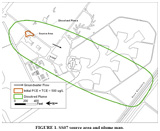 #1 - Field demonstration of substrate distribution for accelerated anaerobic biodegradation at Dover AFB, Delaware
#1 - Field demonstration of substrate distribution for accelerated anaerobic biodegradation at Dover AFB, Delaware
Demonstrates SRS® Radius of Influence and Longevity
An evaluation of the substrate distribution also at Dover AFB, Delaware in another plume. Distribution of the oil in the soil matrix was found up to 22 feet from the injection well.
Bloom, A., G. DeLong, W. Ahlers, D. Williams, R. Lyon, L. Stenberg, A. Buell, and M. Lee. 2008a. Field demonstration of substrate distribution for accelerated anaerobic biodegradation at Dover AFB, Delaware. In: B. M. Sass (Conference Chair), Remediation of Chlorinated and Recalcitrant Compounds—2008. Proceedings of the Sixth International Conference on Remediation of Chlorinated and Recalcitrant Compounds (Monterey, CA; May 2008). Battelle, Columbus, OH, Paper E-030. -
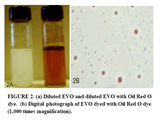 #2 - Accelerated anaerobic bioremediation of a PCE source area. Two years later at Site SS07, Dover AFB, DE.
#2 - Accelerated anaerobic bioremediation of a PCE source area. Two years later at Site SS07, Dover AFB, DE.
Demonstrates SRS® Radius of Influence and Longevity
Discusses a project at Dover Air Force Base, Delaware where 102,000 gallons of EVO, sodium lactate, nutrients, and water were applied. TOC levels as high as 4,860 mg/L were achieved with elevated TOC levels lasting for 21 months. PCE and TCE concentrations fell below maximum contaminant levels (MCLs) within one year. Daughter products including cis-DCE, VC, and ethene were generated.
Bloom, A., G. DeLong, L. Stenberg, R. Lyon, and A. Buell. 2008b. Accelerated anaerobic bioremediation of a PCE source area. Two years later at Site SS07, Dover AFB, DE. In: B. M. Sass (Conference Chair), Remediation of Chlorinated and Recalcitrant Compounds—2008. Proceedings of the Sixth International Conference on Remediation of Chlorinated and Recalcitrant Compounds (Monterey, CA; May 2008). Battelle, Columbus, OH, Paper C-091. -
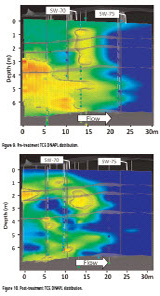 #3 - Contaminated Land: Applications in Real Environments. 2010. SABRE Bulletin SAB 5. Overview of the SABRE Field Tests
#3 - Contaminated Land: Applications in Real Environments. 2010. SABRE Bulletin SAB 5. Overview of the SABRE Field Tests
Demonstrates SRS® Radius of Influence and Longevity
Discusses the SABRE project in the UK where SRS was applied for the bioremediation of dense nonaqueous phase liquid (DNAPL) TCE (Contaminated Land: Applications in Real Environments 2010). A 98 foot long x 13 foot wide by 13 foot deep test cell was constructed in a TCE DNAPL impacted area containing an estimated 5,300 pounds of TCE. About 5,280 pounds of 60% SRS®-SD was applied along with a dechlorinating culture. The test cell was pumped to maximize flow through the cell. About 60% of the TCE was removed from the cell as TCE and daughter products within the 20 months of operation. The project demonstrated that DNAPL TCE could be biologically degraded.
Contaminated Land: Applications in Real Environments. 2010. SABRE Bulletin SAB 5. Overview of the SABRE Field Tests. -
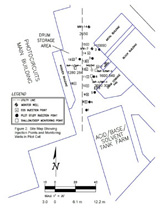 #4 - EVO carbon footprint, distribution, and longevity: Summary of SRS® case histories
#4 - EVO carbon footprint, distribution, and longevity: Summary of SRS® case histories
Demonstrates SRS® Radius of Influence and Longevity
Discusses the mobility and longevity of 60% SRS®-SD at five sites. EVO distribution and persistence is affected by site characteristics, substrate loadings, and the injection methodology with TOC distribution generally limited to about 20 feet (6.1 m) from the injection points and lasting from 80 to 2,529 days.
Lee, M. D., J. E. Lee, and R. L. Raymond, Jr. 2013. EVO carbon footprint, distribution, and longevity: Summary of SRS® case histories. E-21, in: R.R. Sirabian and R. Darlington (Chairs), Bioremediation and Sustainable Environmental Technologies—2013. Second International Symposium on Bioremediation and Sustainable Environmental Technologies (Jacksonville, FL; June 10–13, 2013), Battelle Memorial Institute, Columbus, OH. www.battelle.org/biosymp -
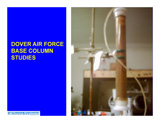 #5 - Emulsified Vegetable Oil Transport Studies in Soil Columns
#5 - Emulsified Vegetable Oil Transport Studies in Soil Columns
Demonstrates SRS® Radius of Influence and Longevity
Column studies were conducted to evaluate the transport of SRS-SD (small droplet) and SRS-FR (larger droplets). Injection of a 1 part EVO and 4 parts water mixture followed by chase water allowed for greater transport of the emulsion than injection of the more diluted EVO. The finer droplet size formulation moved through the soil column easier than the larger droplet size EVO, thus providing better distribution throughout the formation. EVO was detected in the effluent of the soil columns only after about one pore volume of the SRS or SRS-FR. Fatty acid methyl ester (FAME) analysis of water samples proved useful in determining the presence of vegetable oil whereas TOC also measures the presence of lactate. Hexane extraction and FAME analysis served as useful methods in determining the presence of vegetable oil in soil samples.
Lee, M. D., R.L. Raymond, and S. Cole, L. Stenberg and R. Lyon, and D. Williams. 2009. Emulsified Vegetable Oil Transport Studies in Soil Columns. Paper L-82, in: G.B. Wickramanayake and H.V. Rectanus (Chairs), In Situ and On-Site Bioremediation—2009. Tenth International In Situ and On-Site Bioremediation Symposium (Baltimore, MD; May 5–8, 2009). ISBN 978-0-9819730-1-2. Publisher: Battelle Memorial Institute, Columbus, OH. www.battelle.org/biosymp -
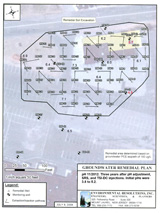 #6 - Buffering Acidic Aquifers with Soluble Buffer to Promote Reductive Dechlorination
#6 - Buffering Acidic Aquifers with Soluble Buffer to Promote Reductive Dechlorination
Demonstrates the benefit of buffering the dilution and chase water during injections
The groundwater pH at the site was about 4.8. Sodium carbonate was chosen as the buffering agent. A total of 52,500 pounds of SRS, 9,900 pounds of sodium carbonate, and 323,000 gallons of groundwater were injected into the 180 by 384 x 25 foot thick treatment area.
Lee, M. D., E. Hauptmann, and R.L. Raymond, D. Ochs, R. Lake, and M. Selover. 2010. Buffering Acidic Aquifers with Soluble Buffer to Promote Reductive Dechlorination. F-031, in K.A. Fields and G.B. Wickramanayake (Chairs), Remediation of Chlorinated and Recalcitrant Compounds—2010. Seventh International Conference on Remediation of Chlorinated and Recalcitrant Compounds (Monterey, CA; May 2010). ISBN 978-0-9819730-2-9, Battelle Memorial Institute, Columbus, OH, www.battelle.org/chlorcon. -
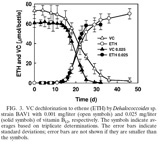 #7 - Influence of Vitamin B12 and co cultures on the growth of Dehalococcoides isolates in defined medium
#7 - Influence of Vitamin B12 and co cultures on the growth of Dehalococcoides isolates in defined medium
Demonstrates the benefit of Vitamin B12 in the anaerobic dechlorination process
Dehalococcoides (DHE) are commonly found in mixed microbial communities with fermenters such as Desulfovibrio, Eubacterium, Acetobacterium, Citrobacter, and Clostridium. These organisms ferment a wide variety of compounds such as hexoses, lactate, pyruvate, and butyrate into H2 and acetate. DHE cannot synthesize corronoids, but a wide variety of bacteria in nature can produce vitamin B12. . The hydrogen threshold for DHE is less than 0.4 ppm which allows them to compete with other hydrogen-utilizing bacteria like methanogens and sulfate-reducers. Tests were performed with Vitamin B12 from 1 to 200 µg/L. At 25 µg/L, TCE dechlorination rates doubled and the final ethene to VC ratio increased. No improved dechlorination rates or growth was observed for higher levels of Vitamin B12. The addition of other strains that can produce vitamin B12 can overcome a vitamin B12 deficiency.
He, J., V. F. Holmes, P. K. H. Lee, and L. Alvarez-Cohen. 2007. Influence of Vitamin B12 and cocultures on the growth of Dehalococcoides isolates in defined medium. Applied and Environnemental Microbiology 73(9):2847-2853. -
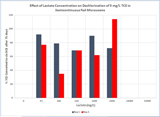 #8 - Bioaugmentation for accelerated in situ anaerobic bioremediation
#8 - Bioaugmentation for accelerated in situ anaerobic bioremediation
Demonstrates the benefit of bioaugmentation, nutrients and lactate in the anaerobic dechlorination process
The first successful anaerobic bioaugmentation project was carried out on a trichloroethene (TCE)-contaminated aquifer at Dover Air Force Base, DE, using a microbial enrichment culture capable of dechlorinating TCE to ethene. A hydraulically controlled pilot system 40 by 60 feet was constructed 50 feet below ground surface in an alluvial aquifer to introduce nutrients and substrate into the groundwater. Ambient TCE and cis-1,2-dichloroethene (cDCE) concentrations in groundwater averaged 4800 and 1200 g/L. The pilot operated for 568 days. Results by day 269 confirmed previous laboratory work showing that dechlorination did not proceed past cDCE with most of the TCE was dechlorinated to cDCE. An ethene-forming microbial enrichment culture from the Department of Energy’s Pinellas site in Largo, FL, was injected into the pilot area. After a lag period of about 90 days, vinyl chloride and ethene began to appear in wells. The injected culture survived and was transported through the pilot area. By day 509, TCE and cDCE were fully converted to ethene.
Ellis, D. E., E. J. Lutz, J. M. Odom, R. J. Buchanan, Jr., C. L. Bartlett, M. D. Lee, M. R. Harkness, and K. A. DeWeerd. 2000. Bioaugmentation for accelerated in situ anaerobic bioremediation. Environmental Science and Technology 34.2254-2260.


